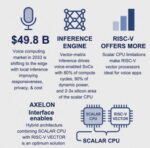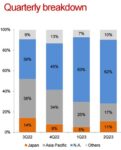You are currently viewing SemiWiki as a guest which gives you limited access to the site. To view blog comments and experience other SemiWiki features you must be a registered member. Registration is fast, simple, and absolutely free so please,
join our community today!
Essential Debugging Techniques Workshop
This workshop is for hardware engineers, system architects, and anyone who wants to learn best practices for debugging challenging issues encountered while developing FPGAs, SoCs, PCBs, and embedded systems using the Vivado Design Suite. The features and capabilities of the Vivado
…
Read More
Defacto has been a leading provider of SoC integration tools for large-scale designs for years. Most major semiconductor companies already use their solutions, and several customers will be presenting how they leverage the Defacto solution (SoC Compiler) at the upcoming DAC conference.
This year, Defacto is announcing a major… Read More
When Apple introduced Siri in 2011, it was the first serious attempt to make voice interaction a mainstream user interface. Embedded into the iPhone 4S, Siri brought voice into consumers’ lives not as a standalone product, but as a built-in feature—a hands-free way to interact with an existing device. Siri set the expectation… Read More
IC designs need to operate reliably under varying conditions and avoid inefficiencies like leakage across power domains. But how do you verify that connections between IP blocks has been done properly? This is where reliability verification, Electrical Rule Checking (ERC) tools and dynamic simulations all come into play particularly… Read More
Daniel Nenni is joined by Dr. Sailesh Kumar, CEO of Baya Systems. With over two decades of experience, Sailesh is a seasoned expert in SoC, fabric, I/O, memory architecture, and algorithms. Previously, Sailesh founded NetSpeed Systems and served as its Chief Technology Officer until its successful acquisition by Intel. Sailesh… Read More
In the early days an IC had a single clock and a single reset signal, making it a simple matter to reset the chip into a known, stable state, so there was little need for detailed analysis. For modern designs there can be dozens to hundreds of clocks, creating separate domains and some use of asynchronous resets, so the challenge of ensuring… Read More
The ASIC business has always been a key enabler of the semiconductor industry but it is a difficult business. In my 40 years I have seen many ASIC companies come and go but I have never seen one like Alchip.
Alchip Technologies Ltd. was founded more than 20 years ago, about half way through my career. I know one of the founders, a fiercely… Read More
As the complexity of modern System-on-Chip (SoC) designs continues to rise, achieving energy efficiency measured as performance per watt has become a crucial design goal. With the increasing demand for powerful, multifunctional chips, balancing performance with power consumption has become essential. Realistic workloads… Read More
The Design Automation Conference (DAC) is a premier event that focuses on the design and automation of electronic systems. It is an annual conference that has been held since 1964, making it one of the longest-running and most established events in the field of electronic design automation (EDA).
DAC offers outstanding training,… Read More
Dieter Therssen obtained his master’s degree in Electronics Engineering from KU Leuven in 1987. He started his career as a hardware design engineer, using IMEC’s visionary tools and design methodologies in the early days of silicon integration.
Since then, Dieter developed his career across many digital technologies,… Read More







